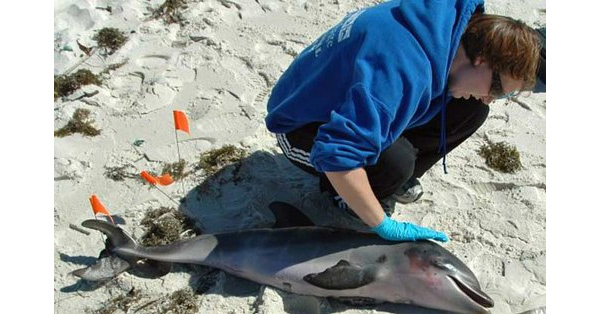| Dolphin Deaths in Gulf of Mexico Due to BP Oil Spill and the 'Perfect Storm' Christine Lepisto - treehugger.com | |
| go to original July 22, 2012 |
|

(U. Central Florida Research)
After the BP Deepwater Horizon oil spill, the largest oil spill on open water to date, residents along the northern coast of the Gulf of Mexico witnessed a spike in the numbers of dolphins washing ashore. Suspicions linking the increase in dolphin deaths to the oil contamination led authorities to treat the dead dolphins as evidence against BP.
Stillborn Dolphins
Almost half of the dead dolphins were young, many described as "perinatal," or near birth. Studies quickly indicated that many of the baby dolphins were stillborn. But the cause of the increase in stillbirths - 6 times the average rate - as well as dolphin strandings in general remained unclear.
A study published in PLoS ONE now attributes the dolphin deaths to a "Perfect Storm" of stressors, starting with the depletion of the food chain relied upon by dolphins, leaving the dolphins weakened and unable to survive a series of temperature drops as larger than average snow melt volumes flooded into the gulf.
"Perfect Storm"
The team of biologists who conducted the study present novel evidence that the three peaks in dolphin deaths observed in early 2011 each follow a temperature drop by a period of 2-3 weeks, linking the immediate cause of dolphin deaths to cold. But the temperatures alone cannot explain the dolphin deaths, as they lie within ranges that a healthy dolphin population can typically survive.
The scientists then review the results of several studies demonstrating that the food supplies relied on by dolphins dropped prior to the period of dolphin deaths. The authors track how these changes in the dolphins' ecosystem lead to emaciation, physiological stress, and depressed immune systems in gulf dolphins. Critically, the reduced quality of blubber left dolphins more exposed to cold temperatures, and the other stresses rendered them unable to employ the mechanisms that typically keep dolphins safe in the temperature ranges experienced in the spring of 2011.
Graham Worthy, of the University of Central Florida, sums it up:
Unfortunately it was a ‘perfect storm’ that led to the dolphin deaths. The oil spill and cold winter of 2010 had already put significant stress on their food resources, resulting in poor body condition and depressed immune response. It appears the high volumes of cold freshwater coming from snowmelt water that pushed through Mobile Bay and Mississippi Sound in 2011 was the final blow.
So Is BP to Blame?
The authors of the study certainly suggest that the Deepwater Horizon oil spill contributed to the peak of dolphin deaths, but the evidence falls short of producing a direct link. The fact that the study indicates temperature drops due to snow melt run-off as the proximate cause of dolphin deaths will surely be pounced upon by lawyers seeking to blame natural causes.
The picture is further complicated by the fact that the snow melt peaks trace back to unusual patterns of cold weather, which themselves contributed to stresses on the food chain and dolphins themselves, prior to the final blow perpetrated by the spring snow melt. This evidence gives lawyers a further opportunity to blame the weather rather than oil contaminants for the damage to the gulf ecosystem.
We invite you to add your charity or supporting organizations' news stories and coming events to PVAngels so we can share them with the world. Do it now!
Celebrate a Healthy Lifestyle
 From activities like hiking, swimming, bike riding and yoga, to restaurants offering healthy menus, Vallarta-Nayarit is the ideal place to continue - or start - your healthy lifestyle routine.
From activities like hiking, swimming, bike riding and yoga, to restaurants offering healthy menus, Vallarta-Nayarit is the ideal place to continue - or start - your healthy lifestyle routine.